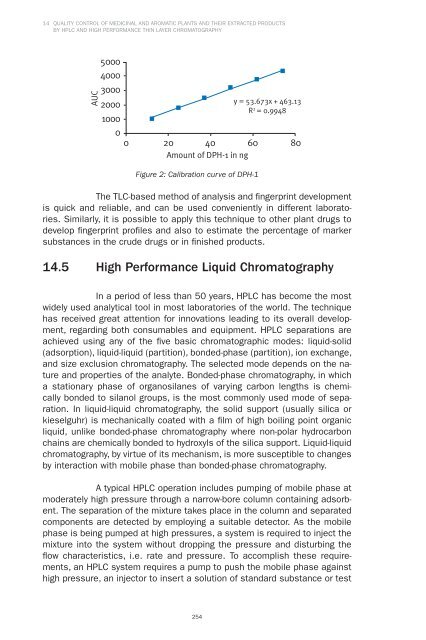Extraction Technologies For Medicinal And Aromatic Plants - Unido
Extraction Technologies For Medicinal And Aromatic Plants - Unido
Extraction Technologies For Medicinal And Aromatic Plants - Unido
Create successful ePaper yourself
Turn your PDF publications into a flip-book with our unique Google optimized e-Paper software.
14 QUALITY CONTROL OF MEDICINAL AND AROMATIC PLANTS AND THEIR EXTRACTED PRODUCTS<br />
BY HPLC AND HIGH PERFORMANCE THIN LAYER CHROMATOGRAPHY<br />
���<br />
����<br />
����<br />
����<br />
����<br />
����<br />
�<br />
�<br />
�� �� �� ��<br />
���������������������<br />
Figure 2: Calibration curve of DPH-1<br />
254<br />
��������������������<br />
� �� ��������<br />
The TLC-based method of analysis and fi ngerprint development<br />
is quick and reliable, and can be used conveniently in different laboratories.<br />
Similarly, it is possible to apply this technique to other plant drugs to<br />
develop fi ngerprint profi les and also to estimate the percentage of marker<br />
substances in the crude drugs or in fi nished products.<br />
14.5 High Performance Liquid Chromatography<br />
In a period of less than 50 years, HPLC has become the most<br />
widely used analytical tool in most laboratories of the world. The technique<br />
has received great attention for innovations leading to its overall development,<br />
regarding both consumables and equipment. HPLC separations are<br />
achieved using any of the fi ve basic chromatographic modes: liquid-solid<br />
(adsorption), liquid-liquid (partition), bonded-phase (partition), ion exchange,<br />
and size exclusion chromatography. The selected mode depends on the nature<br />
and properties of the analyte. Bonded-phase chromatography, in which<br />
a stationary phase of organosilanes of varying carbon lengths is chemically<br />
bonded to silanol groups, is the most commonly used mode of separation.<br />
In liquid-liquid chromatography, the solid support (usually silica or<br />
kieselguhr) is mechanically coated with a fi lm of high boiling point organic<br />
liquid, unlike bonded-phase chromatography where non-polar hydrocarbon<br />
chains are chemically bonded to hydroxyls of the silica support. Liquid-liquid<br />
chromatography, by virtue of its mechanism, is more susceptible to changes<br />
by interaction with mobile phase than bonded-phase chromatography.<br />
A typical HPLC operation includes pumping of mobile phase at<br />
moderately high pressure through a narrow-bore column containing adsorbent.<br />
The separation of the mixture takes place in the column and separated<br />
components are detected by employing a suitable detector. As the mobile<br />
phase is being pumped at high pressures, a system is required to inject the<br />
mixture into the system without dropping the pressure and disturbing the<br />
fl ow characteristics, i.e. rate and pressure. To accomplish these requirements,<br />
an HPLC system requires a pump to push the mobile phase against<br />
high pressure, an injector to insert a solution of standard substance or test

















